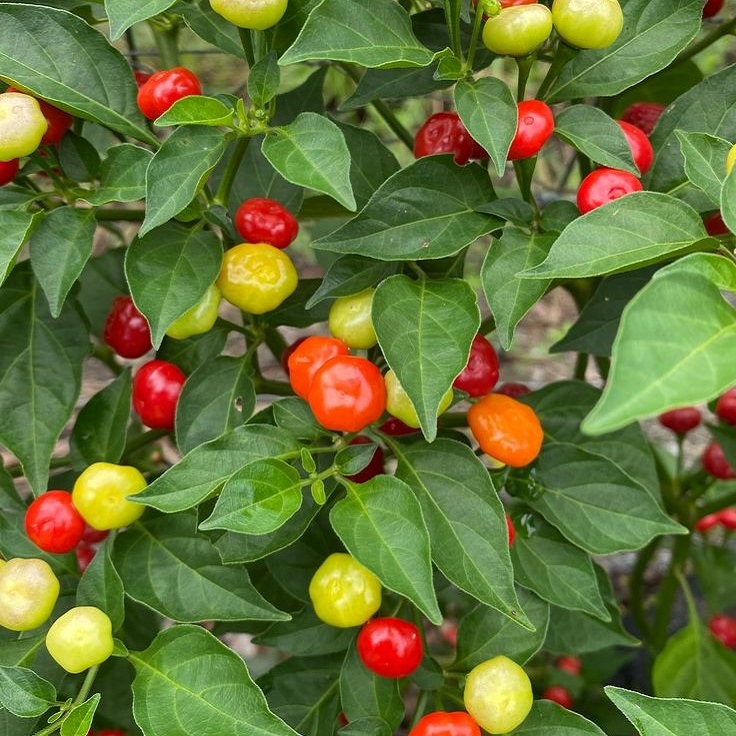Introduction to Decorative Pepper Plants
Decorative pepper plants are stunning and versatile. Their vibrant colors bring life to any indoor space. These plants, often small in stature, showcase a mix of greens, reds, purples, and yellows. Easy to care for, they flourish indoors, becoming a part of your decor. They serve a dual purpose – beautifying your space and spicing up your dishes. Though edible, their taste is secondary to their ornamental value. In this blog, we’ll guide you through everything about decorative pepper plants. From their origin to their care, we cover it all. Let’s explore these colorful gems and learn how to make them thrive in your home.

Origin and Types of Decorative Peppers
Decorative pepper plants, scientifically known as Capsicum annuum, have a rich history. Native to the Americas, these plants have spread globally thanks to their visual appeal and ease of growth. There are several types of decorative peppers, each with unique colors and shapes. The most common include the petite ‘Chilly Chili’, the dark and mysterious ‘Black Pearl’, and the fiery ‘Basket of Fire’. Careful breeding has produced varieties with a range of colors and spice levels. Ornamental peppers can feature fruits in red, purple, yellow, orange, black, or white. The peppers often change colors as they ripen, offering a display of multiple hues on a single plant. Whether displayed in a garden bed or indoor pot, these peppers add a pop of color wherever they grow.
Are Decorative Peppers Edible?
Decorative pepper plants indeed produce fruits that you can eat. However, their main role is for show, not flavor. Many find ornamental peppers too hot for their taste. They can range from mild to extremely fiery. The typical taste profile is either grassy or bitter. It’s essential to mention that while the peppers are edible, the leaves are not. They can cause stomach issues in humans and can be deadly to pets. If you choose to eat them, remember they are not bred for culinary use. There are varieties that register high on the Scoville scale. If you do decide to add these peppers to your plate, proceed with caution. Use them sparingly to bring heat to dishes, or as colorful garnishes. Always ensure they’re thoroughly washed before consumption, especially if not homegrown.
How to Grow Decorative Peppers Indoors
Cultivating decorative pepper plants indoors is both doable and a delight! With proper care, these vibrant plants will produce fruit to brighten up your home. The process to grow them is straightforward but demands some attention.
Firstly, start your peppers indoors using small pots with potting soil or a seeding medium. Seeds should be buried about a quarter to half an inch deep. It usually takes one to two weeks for seeds to germinate. After this, another six to eight weeks passes before seedlings are ready for transplanting.
If starting in a seeding medium, begin fertilizer application three weeks after germination. Use a half-strength liquid fertilizer every two weeks. If potting soil is your medium of choice, it likely has enough nutrients for initial growth stages.
When transplanting, choose a sunny spot in your home. These plants adore sunlight and require it for fruit production. Make sure to use a rich, well-draining soil mix, and space the plants as suggested on the seed packet.
For those preferring container growth, employ pots that are 6 to 8 inches in diameter. Good quality, general-purpose potting soil is ideal for potted decorative peppers.
Remember, decorative pepper plants thrive with minimal care. They will reward you with a cascade of color, right from the comfort of your indoor spaces.
 Requirements for Sunlight and Heat
Requirements for Sunlight and Heat
Decorative pepper plants love the sun and need warmth to flourish. They require a sunny location with at least six to eight hours of direct sunlight per day. This exposure is vital for them to produce their vibrant fruits. If you’re growing them indoors, a south-facing window offers the best light.
During winter months, natural light may not be enough. You might need to supplement it with grow lights. Position the lights a few inches above the plants for effective growth. Keeping the lights on for about 10-12 hours a day should compensate for shorter days.
These plants prefer warmer temperatures, ideally between 70-80 degrees Fahrenheit. They don’t tolerate cold well, so avoid placing them near drafty windows or doors. If you keep your home cooler, consider using a seedling heat mat underneath the pots.
Heat is as crucial as light for these plants. It helps them produce capsaicin, which gives peppers their heat. Without sufficient warmth, the decorative peppers may not develop their characteristic spiciness or could be less colorful. Therefore, maintaining a stable warm environment is key for the health and vibrancy of your decorative pepper plants.
Watering and Fertilizing Decorative Peppers
To keep your decorative pepper plants thriving, proper watering and fertilizing are key. Here’s how to manage these critical aspects effectively.
Watering Your Decorative Peppers
Ensure consistent moisture without overwatering. Allow the soil’s top inch to dry out between watering sessions. Decorative peppers dislike soggy conditions, which can lead to root rot. During hotter periods, they may need more frequent watering. If in doubt, check soil moisture with your finger before adding water.
Watch for signs of underwatering too, like wilted or drooping leaves. If this happens, give your plant a thorough watering. For potted plants, ensure pots have drainage holes to avoid waterlogging.
Fertilizing Your Decorative Peppers
Decorative peppers benefit from regular feeding. Use a balanced liquid fertilizer every two to three weeks during the growing season. This helps promote robust growth and bountiful fruiting.
Reduce the frequency of fertilization once the plant starts fruiting. Too much fertilizer can harm the plant and affect fruit quality. Always follow the directions on your fertilizer’s label for the best results.
By monitoring these elements, your decorative peppers will remain healthy and vibrant.
Potential Pests and How to Manage Them
Decorative pepper plants may attract certain pests. These pests can include aphids, spider mites, and whiteflies. It’s important to manage them to keep your plants healthy.
Aphids
Aphids are small, sap-sucking insects. They often cluster on the undersides of leaves. A strong water spray can dislodge aphids. For severe infestations, use insecticidal soap.
Spider Mites
Spider mites are tiny spiders that cause yellowing leaves. They produce fine webs on plants. Increase humidity to deter spider mites. If you find them, apply neem oil or use a miticide.
Whiteflies
Whiteflies are small, white-winged insects. They swarm when disturbed. Use yellow sticky traps to catch whiteflies. If needed, follow up with insecticidal soap or neem oil treatments.
Regularly inspect your decorative pepper plants. Look for signs of pests, such as damaged leaves or sticky residue. Early detection makes management easier. Keep your plants strong with good care practices. This includes proper watering, sunlight, and fertilization. Healthy plants are less likely to suffer from pest issues. If problems arise, use organic and safe treatments to protect your plants and home environment.
 Creative Uses and Display Ideas for Decorative Peppers
Creative Uses and Display Ideas for Decorative Peppers
Decorative pepper plants are not just for growing. Use them creatively around your home. Here are ideas for display and uses that highlight their beauty and versatility.
As Colorful Centerpieces
Create eye-catching centerpieces using potted decorative peppers. Choose vibrant varieties for a stunning display. They make great conversation starters at dinner parties.
In Themed Decor
Match decorative peppers with seasonal themes. For example, use orange and black peppers for Halloween. They bring a festive touch to your holiday decor.
As Natural Artwork
Arrange different pepper plants together. This creates a natural artwork in your home. Display them on shelves or windowsills for maximum visual impact.
In Edible Landscapes
While not grown for taste, some mild decorative peppers can be used in cooking. Add them to dishes for a pop of color and subtle heat. They double as garnishes for a visual feast.
As Gifts
Decorative pepper plants make unique and thoughtful gifts. They’re perfect for plant lovers or as housewarming presents. Everyone appreciates the gift of greenery.
By integrating these ideas, your decorative pepper plants become more than just houseplants. They are part of your home’s character and charm. With these display ideas, you’ll enjoy their vibrant colors in new and exciting ways. Remember to keep the balance of care, ensuring your peppers thrive as they beautify your space.









